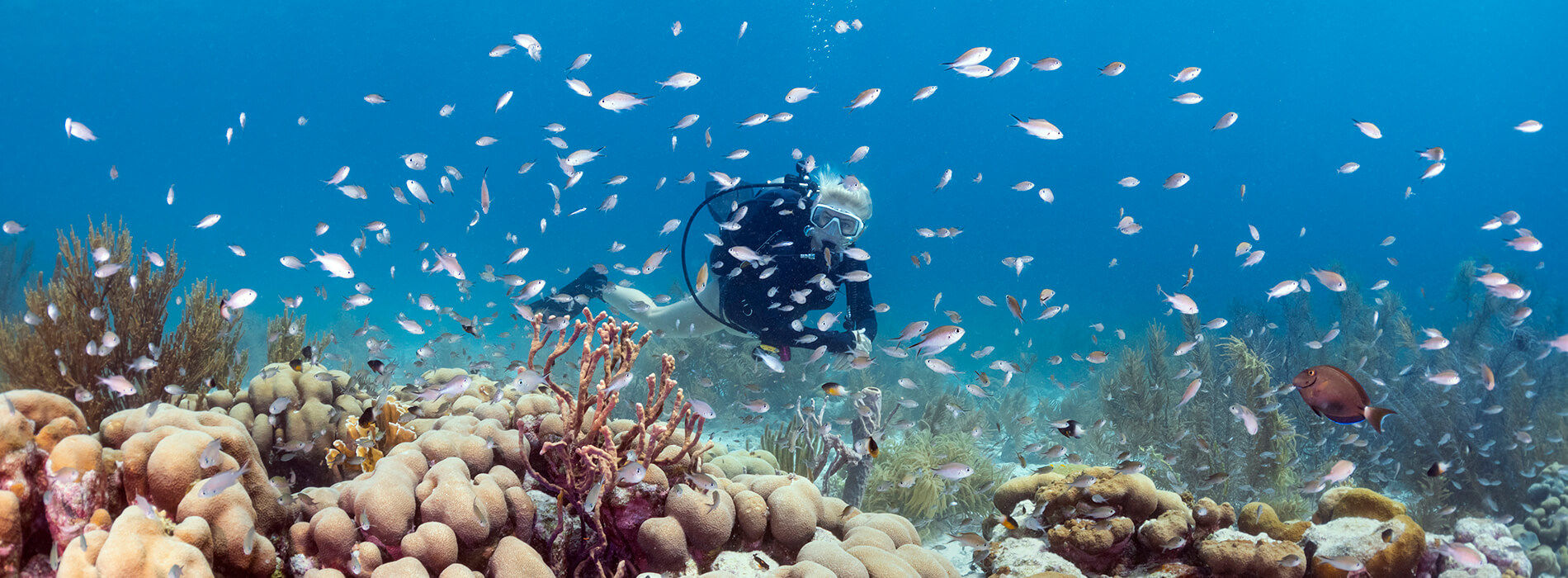
A chip shot away from the dock, the sunlit shallows transition to turquoise then fades to cobalt blue, signaling the edge of the drop-off. The mid-morning light catches a flash of silver. It's a tarpon, cruising so close to the pilings that I can make out its individual scales. There's a final adjustment of the dive mask, a giant stride, a brief cloud of bubbles, then the welcoming silence and the familiar sense of weightless relation. It's just another shore dive, just another day at Captain Don's Habitat. But it never gets old.

When shore diving in Bonaire, there's always a temptation to head directly for the deeper water that usually lies just a few dozen fin kicks from shore. But why rush. Today, the shallows are alive with nibbling parrotfish and an undulating school of silversides that ebbs and flows with each reappearance of the tarpon. And as you cross the sand ledge, there's always the chance of sighting a passing turtle or eagle ray.

The siren song of blue water lures me towards the edge. Isolated coral heads begin to appear, then as the sea floor transitions from a shallow shelf to a steep slope, the corals and sponges take over. Bonaire has long been known for its vibrant reefs, and today, I am witnessing the long-term rewards of a program that was set in motion some five decades ago by the namesake founder of Captain Don's Habitat.

Don Stewart sailed into Bonaire in 1972 and never left. Within a year of arriving he set up the island’s first dive operation, and soon gained a reputation as an active defender of the reefs. He was instrumental in banning spearfishing from inland waters, pushing regulations for the protection of corals, creating dive boat moorings to eliminate anchor damage, and helped establish the Bonaire National Marine Park in 1979. Today, the park includes all the waters surrounding Bonaire and the uninhabited island of Klein Bonaire, from the high-tide mark to depths of 200 feet.

Funded by diver contributions in the form of an annual pass, Bonaire's marine park provided a model for cooperative conservation programs now adopted by other islands in the Caribbean and beyond. Like all other divers who visit the waters of Bonaire, a medallion emblazoned with the acronym STINAPA hangs from my BC. This is an indicating that I have paid my annual pass to De Stichting Nationale Parken Bonaire, and have done my small part to ensure that the corals and wetlands of Bonaire will continue to thrive.

My explorations soon bring me to the overturned hull of a boat that perches on the upper rim of the coral-encrusted slope. This 45-foot wreck is known as La Machaca, and on any dive from Captain Don's, it's worth stopping to peek under the inverted gunwales to see if the resident green moray is showing its teeth. At this point, I have options, I can head left or right, drop down to the lower edges of the slope at depths approaching 100 feet, or stay at depths of 30 to 40 feet to extend my bottom time well past the hour mark.

With no time pressure and no agenda, I decided to stick close to home base and spend an enjoyable half hour examining a grove of that holds the promise of a seahorse sighting, then try to determine which lumps of yellow or purple might actually be a frogfish masquerading as a sponge. When the air gauge finally slips below the 1,000 psi mark, I begin a leisurely swim for shore, and possibly a wood-fired pizza from the resort's kitchen enjoyed at a waterfront table overlooking the reef. Captain Don is no longer with us, but each time I visit Bonaire, I'm thankful for his efforts at protecting what he loved, and the marine park that is his legacy.
Thanks to its protected waters and stellar reefs, Bonaire remains one of the most popular dive destinations in the world. Our agents have a personal relationship with Captain Don's Habitat and all of Bonaire's top resorts and operators. To find out more, and start planning your Bonaire dive adventures, give us a call at 800-329-9989 or send a note to sales@caradonna.com.